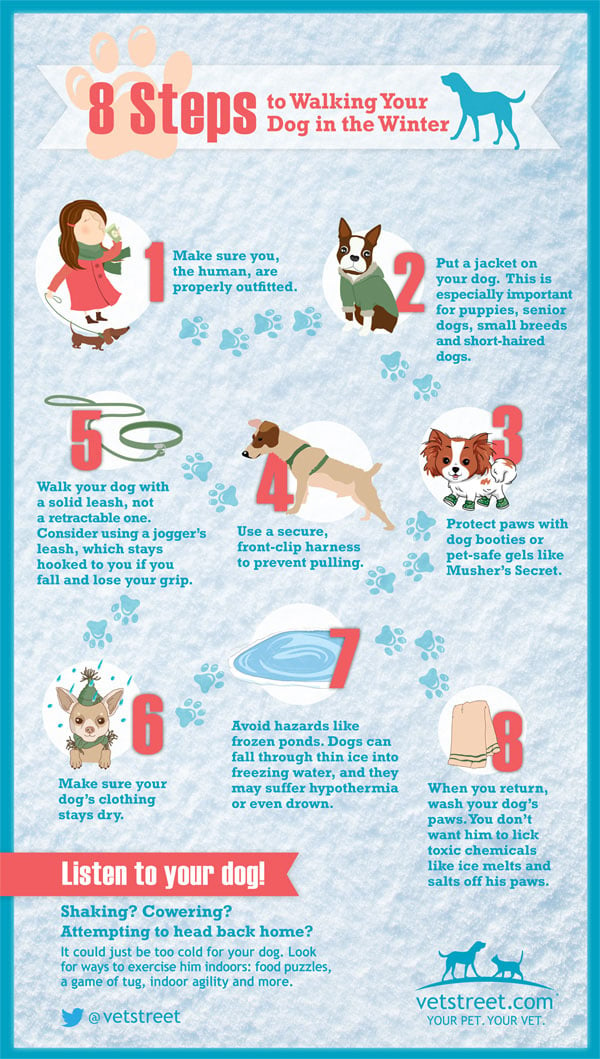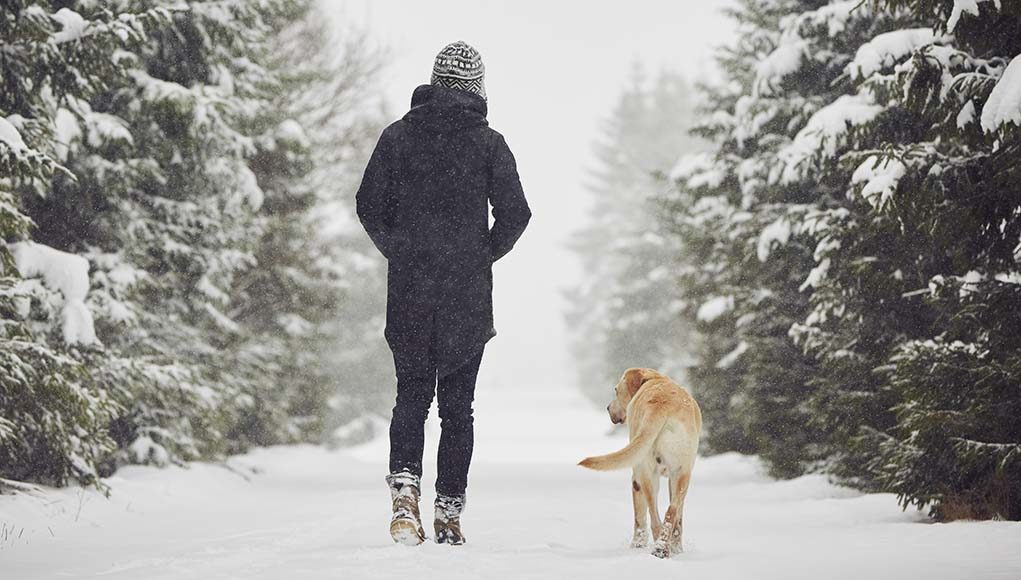October is already here and winter is just around the corner. This means not only preparing yourself for low temperatures, but also getting your dog ready. When the snow falls and there's ice on the road, certain precautions are needed when walking dogs in winter on a regular basis. So here's what you must know.
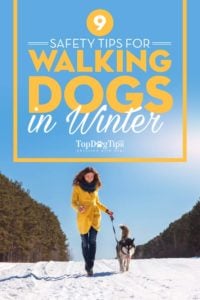 Cold weather can be extremely harmful for dogs. Frostbite, hypothermia, and chemicals are all risks posed for dogs during the winter time. When ice first appears, people use a lot of anti-snow and ice melters that contain harmful chemicals. If you're not using pet safe ice melt or walk in unfamiliar territories, always be aware and take precautions.
Cold weather can be extremely harmful for dogs. Frostbite, hypothermia, and chemicals are all risks posed for dogs during the winter time. When ice first appears, people use a lot of anti-snow and ice melters that contain harmful chemicals. If you're not using pet safe ice melt or walk in unfamiliar territories, always be aware and take precautions.
Ice itself is no friend to dogs either. It can stick to your dog's paws which can make them extremely uncomfortable and even dangerous for paw health. Ice shards can break off and cut your pup's feet. Of course, most dogs still need daily walks, but there are steps you can take to keep your dog safe, comfortable, and healthy on winter walks.
As someone who lives in places with serious polar vortex, I'm not stranger to walking dogs in winter with snow and ice all around. Here are nine tips for you and your dog.
ALSO READ: Dog Paw Care Guide – 7 Things Every Pet Owner Must Know
9 Tips for Walking Dogs In Winter
1. Keep Your Dog’s Toe Hair Clipped
When walking dogs in winter, it takes a little more effort on our part to keep them comfortable. You probably already cut your dog's nails regularly, but it's best to also keep their toe hair clipped at all time. They're tricky to get to but it can protect your dog's paws in the long haul.
Ice can accumulate on this hair, which can make it difficult, or even painful, for your dog to walk. Also, dirt, rock salt, harmful chemicals and other contaminants can become stuck in this hair which can cause extreme discomfort for your dog and eat away at his paws.
If you are walking your dog and notice that he starts to walk slower, limping, stopping or showing other signs that may indicate discomfort and pain, the first place to check is their paws – look for anything that could be stuck in there. For extra protection you can always use dog booties that will prevent anything getting in between your dog's toes.
2. Plan For Weather Conditions
When walking dogs in winter and cold weather, it is especially important to plan out your walks ahead of time. Before you head out, check both the weather and wind chill. If it is colder than normal, be sure to prepare for that and plan how you're going to protect the dog from very low temperatures, snow, ice and rain.
ALSO READ: 9 Tips on How to Protect Your Dog's Paws in Winter
It might be colder out than you thought, which is why it is important to check. On cold days, avoid long routes with only one way back. Instead, choose a busier path with multiple ways back. Preferably, winter walks with your Fido will be shorter. This protects your dog from being exposed to cold weather conditions for too long.
3. Wipe Paws After A Walk
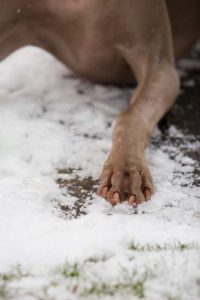 Some pet owners who believe their dogs are “always clean” may neglect this part, but wiping your dog’s paws after a walk is extremely important not just to keep your home clean, but for both the dog's comfort and safety.
Some pet owners who believe their dogs are “always clean” may neglect this part, but wiping your dog’s paws after a walk is extremely important not just to keep your home clean, but for both the dog's comfort and safety.
The best and cheapest way to do this would be to use a warm damp washcloth (not cold, and not hot), and then use another towel to dry the paws off. You can always use a special dog paw wash to make things easier, but they can get costly and aren't always worth it, unless your dog is constantly dirty.
Personally, I always use dog wipes which makes things much easier and quicker. Pet stores sell very cheap and safe pre-moistened dog wipes (don’t use baby wipes) that makes the process much quicker than dealing with washing and drying using regular cloth. Wiping your dog's paws off removes dirt, rock salt, ice, and harmful chemicals used to melt ice off of the pavement. You can also use a doggy doormat to keep home clean.
4. Stay On The Sidewalk
The truth is that most dogs love snow and ice, and enjoy playing in it. But you have to be extremely careful allowing too much freedom when walking dogs in winter. Unless your dog is a breed that is meant for cold weather, such as Alaskan Malamutes and Siberian Huskies, you want to keep them out of deep snow during walks.
When cold snow touches your dogs unprotected stomach, they will become incredibly cold fast. The problem is that you won't know about it, and hypothermia can quickly set in. Many dogs have limited or no fur on their stomachs, which can be dangerous if they are exposed to the snow for too long. It is safest to stick to the sidewalks during walks.
5. Keep Your Dog’s Paws Moisturized
Moisturizing your dog’s paws will prevent them from becoming dried out, which damages them. Dried out paws can cause cracking, splitting, and discomfort for the dog. You should moisturize your dog’s paws before you take them on a walk (but only using special dog paw creams), and once again after you have wiped down their paws.
You can use moisturizer bought at pet stores, or a pet-safe alternative. There are also popular dog paw protection waxes that can be used before walking dogs in winter which protects their paws. There's another type of solutions for dry paws, which can be used after the walk to prevent drying. Coconut oil is another good option, as it is effective, and is even safe for pets if they lick it.
6. Have Them Wear a Dog Sweater
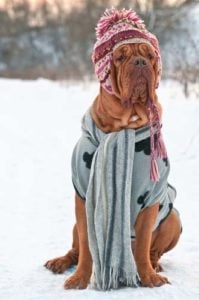 Many people laugh at the idea of pets wearing winter clothes, but it can do wonders when walking dogs in winter in terms of protecting them from the cold. Pet owners often assume that because dogs have furs, they should withstand cold weather and wick off moisture, but that's simply not true – many dogs can't sustain really cold weather.
Many people laugh at the idea of pets wearing winter clothes, but it can do wonders when walking dogs in winter in terms of protecting them from the cold. Pet owners often assume that because dogs have furs, they should withstand cold weather and wick off moisture, but that's simply not true – many dogs can't sustain really cold weather.
A dog sweater can protect your dog from wind, moisture, and adds an extra layer of insulation. However, if a sweater becomes wet, your dog may actually be colder than they would be without one. To protect against this, it is advised to carry multiple sweaters with you if you're going for long walks, or simply head home once the dog is wet. Also, booties and dog socks can protect their paws and add additional level of warmth.
7. Walk Your Dog During The Daytime
In winter months, days are shorter, and it's likely you'll be walking your dog in the dark when doing morning and evening walks. If at all possible, you should do what you can to only walk your dog during the daytime. This protects your dog from getting cold, canine influenza, dog flu and hypothermia. Also, it makes the both of you more visible to oncoming traffic. Daytime walks are simply safer for both you and your dog.
RECOMMENDED: 5 Best Dog Coats for Dogs in Winter
8. Don’t Allow Your Dog To Eat Anything
Not that you should ever let your dog eat things from the ground, but when walking dogs in winter, harmful compounds like anti-freeze, chemical ice melting products, and road salt are all commonly found on pavements and roads. These can all be extremely toxic to your dog. Even pet-safe ones can be harmful to some degree.
To prevent your dog from eating something off the road when you are out on a walk, you should always have him trained how to walk on a leash safely. You can have your dog eat before leaving the house. You can always bring dog treats along for a distraction if needed. The harmful chemicals mentioned could be in the snow and on the ice, which dogs love to lick, so avoid allowing your pet to get too close.
9. Look For Signs That Your Dog Is Too Cold
 When walking dogs in winter, stay vigilant of your dog getting too cold. Normally, you should be able to observe and catch onto cues that he's too cold. Dogs know when they have had enough of the cold weather, and they will let you know.
When walking dogs in winter, stay vigilant of your dog getting too cold. Normally, you should be able to observe and catch onto cues that he's too cold. Dogs know when they have had enough of the cold weather, and they will let you know.
If your dog starts to whine, lick his paws excessively, or shiver excessively, it is time to go inside. The rule of thumb is if it’s too cold for you, it’s too cold for your dog. No dog should be left alone outside during the winter without a warm shelter, such as a dog house with a heater.
Even though winter walks can be more dangerous for your dog than summer walks, they can be made safe if you are taking the right precautions. All of the tips mentioned above will keep your dog safe and comfortable during winter walks. The most important step for safety is understanding your dog and his needs. If you are able to identify if something is wrong, such as them being too cold or being hungry, you will be able to take the steps required to keep them safe.
READ NEXT: DIY Cold Weather Dog House – Keep Your Dog Warm in Winter
